Greetings one and all! My walks have taken me to some of London’s most famous parks including Hyde Park, Green Park, and St James’s Park. Today, I visit another one of the capital’s beauty natural areas, Regent’s Park. From there I’ll go past the distinctive BT (British Telecom) Tower before ending in my final destination of Soho Square!

My journey begins in one of London’s eight Royal Park, Regent’s Park. Designed by John Nash, the park covers 395 acres of land and includes the Queen Mary’s Gardens which features over 12,000 roses of 400 varieties!
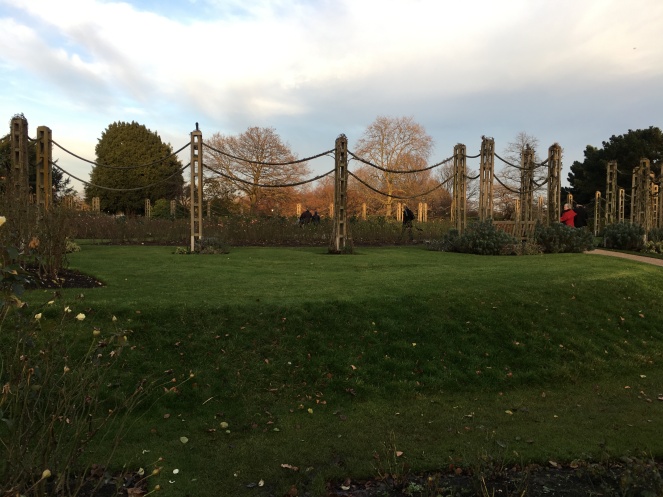
Originally part of the vast Forest of Middlesex, known as Marylebone Park, in 1538 the land was seized by King Henry VIII. He turned the 554 acres of land into a hunting chase, and for the next 50 years it became a place where the King and Queen would entertain visiting dignitaries.

However, between 1649 and 1660 after the Civil War, the Commonwealth Government under Oliver Cromwell chopped down many the park’s trees to help pay off the debts from the war. When Cromwell died, Charles II became King and the park returned to the crown. Over the next 150 years the land was leased out to tenant farmers as hunting had gone out of fashion.

In 1811, there became a greater financial opportunity to start building on parkland than farming on it, and the new Prince Regent, later King George IV, wanted to take advantage of this. This lead to designs being produced for a new summer palace in the grounds.
The government architect, John Nash, was the man behind the redesigned park which was renamed Regent’s Park. The park featured a huge lake, canal, and the new royal residence. 56 villas and a series of grand regency terraces were built within the park by John Nash to pay for it.

However, the Prince’s attention turned to improving Buckingham Palace, so the idea of a summer house didn’t materialise. Nor did the 56 villas either, as only 8 were built! The park was originally only exclusive for residents of the villas and terraces, but in 1835 it was open to the public!

Like most of London during World War Two the park was bombed, with rubble from the buildings that were destroyed being dumped on the park’s lawns. In 1932, the Queen Mary’s Gardens opened to the public, with the rose gardens being completed in 1934.
Today, the beautiful rivers, scrubs, plants and fields provide a reminder of what it was like to be in Regency London. You do feel very lucky to have such stylish and peaceful gardens in London, as you feel like you’re in the countryside, not the centre of a city!


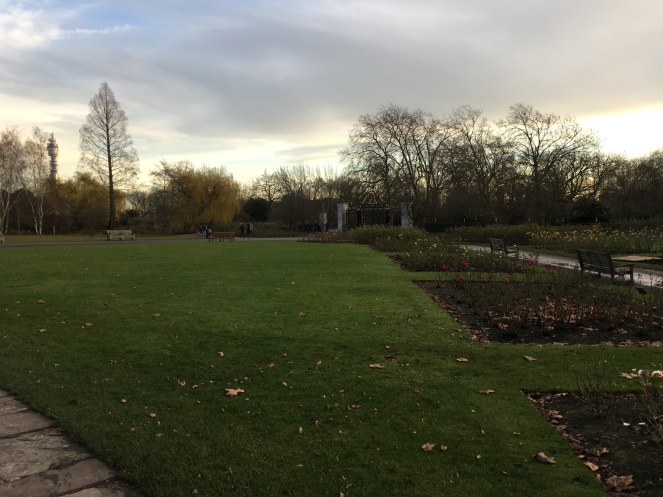
The park also features many sporting facilities with football and cricket pitches. It’s the perfect combination. On one part of the park you have the rivers and plants, and the other the sporting side of a park!

The park also features the amazing Jubilee Gates which are made from iron and were installed to mark the Silver Jubilee of King George V, and the official opening of the Queen Mary’s Gardens in 1935. The gates have Grade II listed status and were donated by Sigismund Goetze who was a wealthy and successful artist that lived in Grove House on the northern perimeter of the park from 1909 to 1939.
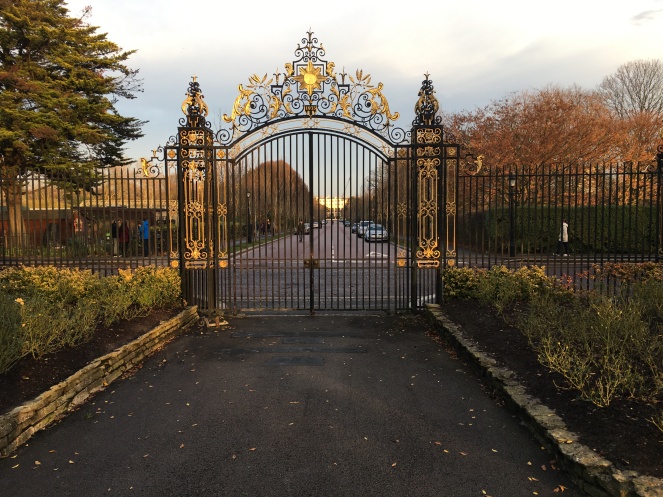
I’d love to stay in the pleasant Regent’s Park, but I’ll continue my walk to Soho Square, and doing so I pass by one of the distinct buildings of the London skyline in Fitzrovia, the BT Tower.
Opened in 1965 by Prime Minster Harold Wilson, the BT Tower was built from 13,000 tonnes of steel and 4,600 square meters of glass. It was commissioned by the General Post Office to support microwave aerials carrying telecommunications transmissions from London to the rest of the country.
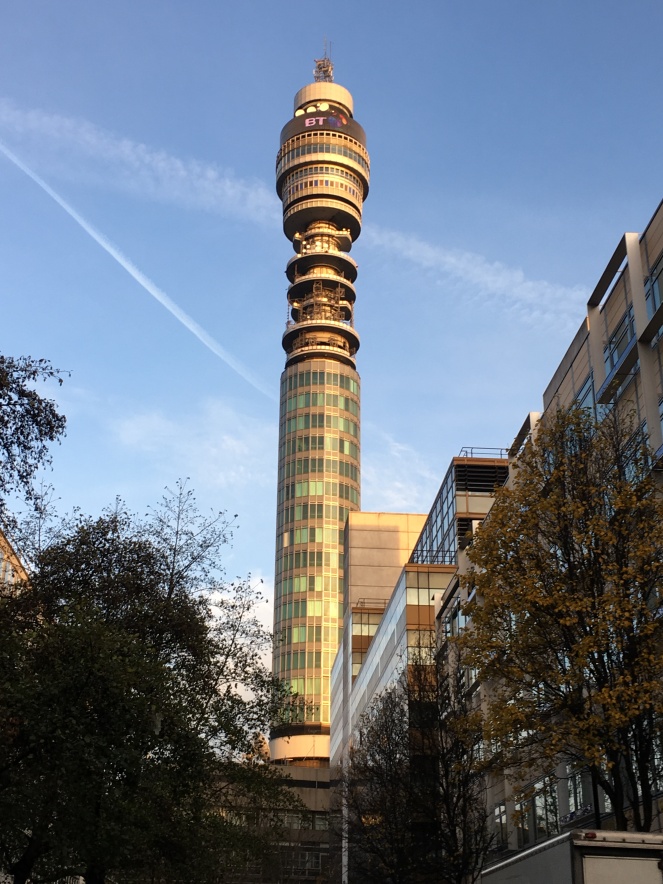
Architects Eric Bedford and G.R.Yeats were the men behind its unique design, with a cylindrical shape chosen for it so the building wouldn’t shift no more than 20cm in the high winds. The aerials on the tower were originally designed to handle up to 150,000 simultaneous telephone conversations and 40 television channels! Imagine the demand for those aerials now if they were used for WiFi signals…!

The tower stands at 189 metres high which at the time made it the tallest building in London until 1980, when the NatWest Tower overtook it. Today, it’s the 19th tallest building in the capital, and you do sometimes forget it’s there as more notable buildings like The Shard and The Cheesegrater in London get more attention! Over the years the tower has gone by many names including the Museum Tower, the Post Office Tower, the London Telecom Tower, and currently the British Telecom (BT) Tower.
It was awarded Grade II listed status in 2003, and even today it’s still a major broadcasting and communications hub with most UK TV’s passing through it. Regularly fundraising events such as BBC Children in Need are still held there.
With great phone signal in the area by the BT Tower, I now move onto the final destination of today’s walk, Soho Square. Outside Soho Square stands St Patrick’s Church, which is a Roman Catholic Parish Church which was built between 1891 and 1893 and designed by John Kelly. The current structure had replaced an earlier and smaller chapel which was built by Father Arthur O’Leary in the 1790s.

My journey ends in pretty Soho Square which dates back to 1670s and was formally known as King Square after Charles II.
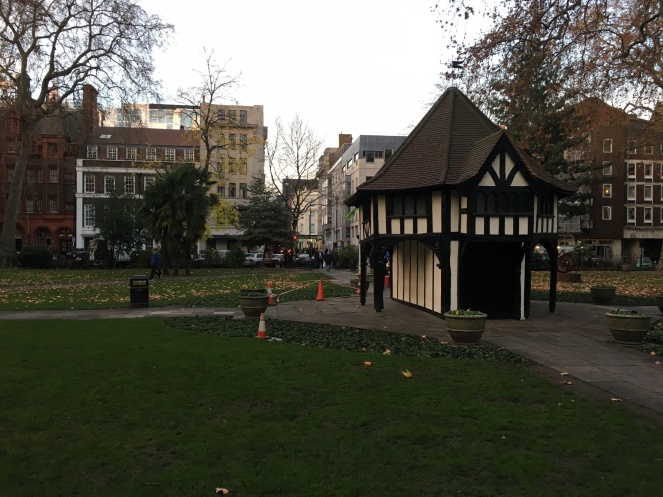
In the middle of the square sits a statue of Charles II which was carved by Danish sculptor Caius Gabriel Cibber in 1681. However, in 1875 when the square was altered it was removed from the square due to its poor state and it was given to artist Frederick Goodall. He placed the statue on the island in his lake at Grim’s Dyke until 1890 when dramatist W.S. Gilbert purchased the property. When Gilbert died in 1911, Lady Gilbert directed it to be returned to the square, and in 1938 it was restored into its original place.

The picturesque Tudor-like hut in the middle surprisingly has only been there since 1925. During World War Two the hut was used as a bomb shelter with 12 inches of brick and a concrete roof to accommodate around 150 to 200 people. However, today I’d love to say there is a magical use for it, but alas, it’s now just a shed, filled with gardening tools to help keep the square looking lovely!

My walk has taken me from one of London’s most famous parks to a secret square via one of London’s tallest building. I hope you found the walk both enjoyable and fascinating, and I look forward to you joining me again next week! In the meantime, why not follow me on Twitter, Instagram and Facebook, and don’t forget to sign up to my blog too.
See you soon!
Sources: (not the food sauces)
All photos taken by London Wlogger. © Copyright 2017
History of Regent’s Park – Royal Parks
History of St Patrick’s Church – St Patrick’s Church

Beautiful route! I love Regent’s park, especially the trip along the canal from Little Venice right through to Camden Town – a few of my favourite places! Not sure if I’ve ever spent any time in Soho Square so will have to pay it a visit next time I’m down in London! Great post!
LikeLiked by 2 people
Aww thank you so much! You can check out my walks through Camden and Little Venice in my previous posts! 😊
LikeLiked by 1 person
Great! I’ll check them out!
LikeLiked by 1 person
Awesome! 😊
LikeLiked by 1 person
Another goodie! I’m up in town tomorrow so I’ll give it a go in the afternoon. *leans against wall and stretches out calf muscles*
LikeLiked by 2 people
Haha excellent, you’ll have a great time I’m sure 😊
LikeLiked by 1 person
Beautiful pictures and that is the beauty of these amazing gardens.👌👌👌👌👌👌
LikeLiked by 1 person
They’re so lovely to walk through and you feel you’re amongst something special 😊
LikeLiked by 1 person
Yes must be
LikeLiked by 1 person
another interesting walk!:)
LikeLiked by 1 person
Thanks Tanja! 😊
LikeLiked by 1 person
Nice to see your perspective. I remember the pelicans.
LikeLiked by 1 person
I do love the wide variety of wildfowl you find in London! 🦆
LikeLiked by 1 person
I think this was the first cloudy walk you posted. Thanks for the ongoing history lessons.
LikeLiked by 2 people
Haha yes it wasn’t the brightest of days, but you still get wonderful photos 😊 my next few upcoming walks are back to clear skies though!
LikeLike
Such a wonderful and exciting walk. The parks look beautiful even at this time of the year. Having lived for many years just opp The Brompton Oratory I know the parks quite well. Thank you for taking us around.
LikeLiked by 2 people
Glad to hear you enjoyed the walk, and thanks for joining me 🙂
LikeLike
ah lovely walk; enjoyed it myself many times but… the zoo! How can you mention Regent’s Park and not the zoo! And then Soho and no mention of the Huguenot Church (I admit to a personal interest – https://geofflepard.com/2016/04/07/f-is-for-the-french-and-the-foreign-atozchallenge/). And then, back when I was small my dad took me up the BT tower to the revolving restaurant at the top… and then the IRA threat gave the PO the excuse to close it to Joe Public and that was that – boo hoo! Keep walking, I’m lovi!ng this
LikeLiked by 1 person
Glad to hear you’re liking all my walks! Haha, ah the focus for me was on the actual park, not so much the Zoo, however, I might do a special feature just on it in the future!
LikeLiked by 1 person
i just love the zoo, even though the metropolitan liberal wimpo in me says I shouldn’t
LikeLike
Thanks again. How long does this walk take?
Beautiful photos. What is your photographic equipment?
LikeLiked by 2 people
You’re very welcome! The walk only takes about 20 minutes, but you’d want to spend plenty of time looking around Regent’s Park 🙂 I’d love to say it’s a fancy camera… but it’s just my iPhone 6S!
LikeLiked by 1 person
Iphone 6S camera is pretty good.
LikeLiked by 1 person
Lovely.
LikeLiked by 1 person
Thank you so much!
LikeLiked by 1 person
Another great post/walk! Good pictures too…not bad for an iPhone 6S. Lol. 😉
LikeLiked by 1 person
Aww thanks so much! It’s as good as a proper camera! 😜
LikeLiked by 1 person
Welcome! I know, right? I mostly use my non-iPhone phone -instead of my proper camera to snap pics. Looking forward to the walk next week! 😉
LikeLiked by 1 person
I’ve thought about getting a proper camera to make the pics look even better, so that might be a future purchase! Excellent, you’ll have a great time 😊
LikeLiked by 1 person
But how can the pics look even better than they already do? Now you’re just showing off. Kidding. Get the camera…;)
LikeLiked by 1 person
Haha, you’re right, why change perfection 😜
LikeLiked by 1 person
Right? Exactly. 😉
LikeLiked by 1 person
I love reading the history behind all these places. I will just have to come back to London so I can do some of your walks.
LikeLiked by 1 person
I’m the same! It’s so fascinating finding out about the areas that I walk through constantly or know of, there are so many stories 😊 Haha, you’ll have lots of fun!
LikeLiked by 1 person
Thanks for the walk down memory lane with the photos and descriptions. Lovely visit.
LikeLiked by 1 person
Glad you enjoyed it, Mary 😊 Thank you so much!
LikeLiked by 1 person
My pleasure. Have a good week ahead.
LikeLiked by 1 person
Thank you, you too!
LikeLiked by 1 person
Another marvelous stroll! Thank you so much. You find all the magical places.
LikeLiked by 1 person
Thanks Anne! It seems wherever you walk in London there is a hidden gem or a place with a fascinating story behind it! 😊
LikeLiked by 1 person
I adore the London parks. Thank you for this post – reminds me why I can’t wait for my next visit to this fabulous city.
LikeLiked by 2 people
There’s nothing quite like a stunning London park! Awesome, you’ll have to try out some of these walks when you’re over 😉
LikeLiked by 1 person
It’s amazing how many different uses some of the historic parks and chases have seen over then centuries. I really enjoyed reading about Regent’s Park. I think Prince Regent, George, abandoning the plans for redevelopment were possibly a good thing. If they’d gone ahead and a summer palace and all the villas had been built, the Park wouldn’t look as it does today. The BT Tower is interesting too – although I thought it was still called the Post Office Tower! (I’m usually a few decades behind). I was a teenager when it was built in the 60s, so it doesn’t seem that old to me. It’s certainly a landmark.
Great post and lovely photos.
LikeLiked by 2 people
You’re so right, Millie! Like Hyde Park as well most of the Royal Parks weren’t open to the public, so it’s great that access restrictions were lifted, otherwise we’d not be able to enjoy their beauty! Haha formally called the Post Office Tower, now 21st century sponsorship 😜 Glad to hear you liked the post 😊
LikeLike
Is the waterfall within the park in Queen Mary’s garden?
LikeLiked by 1 person
It sure is and there’s lots of rivers and ponds within the park too! 😊
LikeLiked by 1 person
Oh wow. How did I miss it? Anyways loving your posts as it is motivating me more to walk this summer. I can’t brave the cold and go for walks right now 😁
LikeLiked by 1 person
Haha yeah I think it’s best to save some of these walks for when the weather gets warmer!
LikeLiked by 1 person
Stunning photos!
LikeLiked by 1 person
Thank you! 😊
LikeLiked by 1 person
Stu, I’ve nominated you for a Blogger Recognition Award! https://mitchteemley.com/2017/02/09/my-blogger-recognition-award/
LikeLiked by 1 person
Thank you very much!
LikeLike
Thanks for sharing! We wish to go there someday 🙂
LikeLiked by 1 person
Awesome, you’ll have a wonderful time! 😊
LikeLike
The gardens…you’ll have to go back when the roses are in bloom.
LikeLiked by 1 person
I’d love to, it’ll look even more beautiful!
LikeLiked by 1 person
stunning – great pix as well as descriptions – thank you 🙂
LikeLiked by 1 person
Thank you very much, glad you liked it 😊
LikeLiked by 1 person
Beautiful walk, great photos, and so much history. Delightful.
LikeLiked by 1 person
Thank you so much, that’s great to hear you liked it 😊
LikeLike
Loved it. :O)
LikeLiked by 1 person
I am SO envious that you live in such a beautiful place, Been wanting to visit Europe for the longest time but never managed to save enough! Thank you for following my blog Stu 🙂
LikeLiked by 1 person
Hopefully you can make it to London to enjoy my walks soon! 😊
LikeLiked by 1 person
Fingers crossed! 😀
LikeLiked by 1 person
Hi! Walking around London is one of my favourite ways to spend my time, so I’m pleased to have come across your blog! Looking forward to trying a few of your routes! Naomi x
LikeLiked by 1 person
Wow that’s amazing to hear, Naomi! Let me know which routes you do! 😊
LikeLiked by 1 person
I will do! I’m new to blogging but I think I’ve managed to follow you!
LikeLiked by 1 person
Excellent, thank you! 😊
LikeLiked by 1 person
Enjoyed your pictures of London – it must be an endless source of inspiration. You remind me of another great “London Walker” – Charles Dickens. Thank you for following my blog – I hope you will get pleasure from the mixture of photography and of history, ancient and modern. Des.
LikeLiked by 1 person
Thanks Des, glad to hear! You’re never too far away from something amazing in London!
LikeLike
Wonderful! The Post Office Tower (BT Tower) originally had a top secret function; so secret, in fact, that it wasn’t supposed to exist and didn’t appear on maps.
LikeLiked by 1 person
Such a cool fact!
LikeLiked by 1 person
I found my way to Soho Square on my last day in London in 2016 and wondered what the dear little hut was all about. Oh dear. The storing of garden tools. Oh well, it looks pretty, anyway.
LikeLiked by 3 people
Haha yeah quite underwhelming!
LikeLike